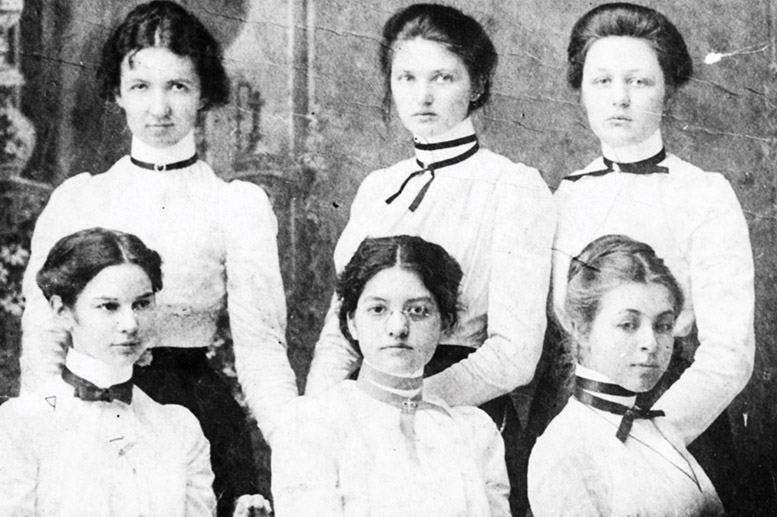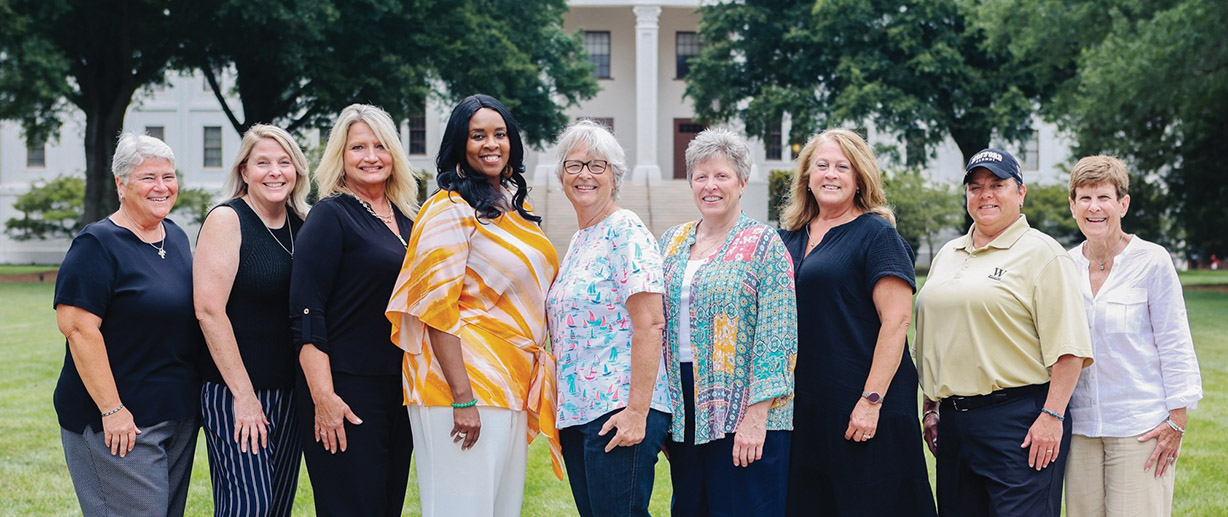By Daniel Brasington ’25, Jo Ann Mitchell Brasington ’89, Indiya Clarke ’26, Robert W. Dalton, Sarah Parlet
THE FIRST TO PLAY
Starting the first women’s athletics teams
Dr. Pam Parnell ’83 graduated from Wofford 40 years ago. She became a veterinarian and a pathologist, a successful entrepreneur in the field of veterinary pathology, a wife and a mother. Before she did all of that, however, she helped bring women’s athletics to Wofford College.
“I was one of a group who said, ‘We want to play ball because we had always played ball,’” says Parnell. “To come here — the college I wanted to attend — and play basketball at any level was a dream.”
Like Parnell, Roberta Hurley ’81 and roommates Karen Weishuhn Harris ’83 and Karen Rhodes Cable ’82 came to the college on academic scholarships, but all jumped at the chance to compete again athletically.
“I was a Ruth Winn Wickware Scholar,” says Harris. “Someone during the admission process told me that they would start a women’s basketball team if I came.”
According to Cable, the women played intramurals with the men her first year. By the second year, they were enlisting other women who had played any sport to join a type of club team.
“Once I remember we played a bunch of DJs from a local radio station, and they showed up roaring drunk,” says Cable.
“I knew we were starting something, but I didn’t know how big it would be,” says Harris. “Some male students at the time let us know that this was supposed to be a school for men. That wasn’t unusual at the time, so starting new things and breaking barriers wasn’t unusual either.”
Cable and Harris also remember the support, namely from James Blair ’83, Kevin Childs ’82, Dirk Derrick ’82, Wade Lang ’83 and Tim Renfrow ’83.
“Some of the guys would come scrimmage us or invite us to their pick-up games,” says Cable. “I remember Wofford professors Deno Trakas, Lee Hagglund and Dennis Wiseman practicing with us, so we’d have enough to play.”
The college enrolled 30 women as residential students in 1978. By the time the first residential women graduated, there were just over 100 women on campus.
“Once we decided to pursue residential co-education, we knew we had to do it right,” says Dr. Joe Lesesne, Wofford president emeritus. “There was some discussion about women maybe preferring a different curriculum, but that’s not what the women wanted. We also learned that they wanted opportunities to participate in intercollegiate athletics.”
Adding women to the student body raised the profile.
According to Dr. B.G. Stephens ’56, who was the dean at the time, “Wofford had descended into mediocrity as an allmale college. I said in a presentation to the board of trustees, you must bring in women if you’re going to survive.” Stephens also copied the college’s charter from the archives and read it to the trustees. “The charter never said that Wofford was to be a college just for men.”
Admitting women brought up the grade point average and SAT scores. Women distinguished themselves from day one — winning election to Campus Union, starting clubs and organizations, and graduating Phi Beta Kappa, as was the case with most of the women who played on the first women’s athletics teams.
Trish Gainey was hired to lead the transition to intercollegiate athletics for women, recruiting student-athletes in the top half of the college’s profile and coaching those first teams. She was honored during Commencement 2023 for the role she played in establishing women’s athletics at the college.
Gainey recruited Meg Hunt ’84, offering the college’s first women’s athletics scholarship.
“Meg was a go-getter, a leader who understood her role and motivated others to do their best,” says Gainey. Hunt continues to be listed at the top of the alltime records lists, including career points.
With Gainey and three scholarships, the women’s volleyball and basketball teams became more competitive, but the women on those first teams still had to select their uniforms off the rack in the bookstore and sell programs to buy sweatpants. They often took the Andrews Field House floor at 5:30 or 6 a.m. to work around classes, labs and practice schedules of the men’s basketball and fencing teams.
“I’m sure the idea of practice space and access for women was foreign at the time,” says Nancy Barr ’84. “At times it’s hard even now for women to have equality, looking back it was mind-blowing to do it in the 1980s. What I remember most, though, was how much fun it was and the camaraderie and community I felt with my team.”
Others in the first group of women agree. The consensus was that the experience wasn’t easy, but those first women in athletics developed resilience, persistence and an appreciation for those who helped further their cause.
“Coach Gainey was amazing because she wasn’t just starting a program, she was also helping the college adjust to having women on campus and helping us adjust to Wofford,” says Hunt.
“I came a little later, but I still remember how grateful I was to Coach Gainey and the students, faculty, staff and donors who supported us,” says Missy Ellenberg Vess ’85.
Tori Quick ’87 continued to build on the legacy of the women who started the program. She was known for her vertical jump and continues to be listed among the most athletic to wear a Wofford uniform. She was a guard on the basketball team and a hitter for volleyball. One of her proudest moments was selection for induction in the Wofford Athletics Hall of Fame, following her father, Vernon Quick ’51, who was inducted in 1981, and Hunt, who was inducted in 1991.
“We talk a lot about highlights during that time, but this is probably the biggest one for me,” says Quick. “Being the first father-daughter pair in the Hall of Fame is the honor of a lifetime.”
Hunt says the women who were student-athletes at the time were compelled to excel.
“We felt like it was up to us to make it work,” she says. “We may not have fully realized the impact we would eventually have, but we did know that we had high expectations of ourselves. We wanted to create a program that we and the college could be proud of.”
Over the summer, many of those first women returned to the campus to talk with current women’s basketball player Indiya Clark ’26, have lunch, take a campus tour and watch a practice before the team left for France for a series of scrimmages and cultural experiences. “Our jaws dropped when we saw the women’s locker room and the facilities in the Jerry Richardson Indoor Stadium,” says Sandy Martin ’85.
“The new facilities brought tears to my eyes,” says Parnell. “We were clueless as students. The realization of what we did didn’t sink in at the time.”
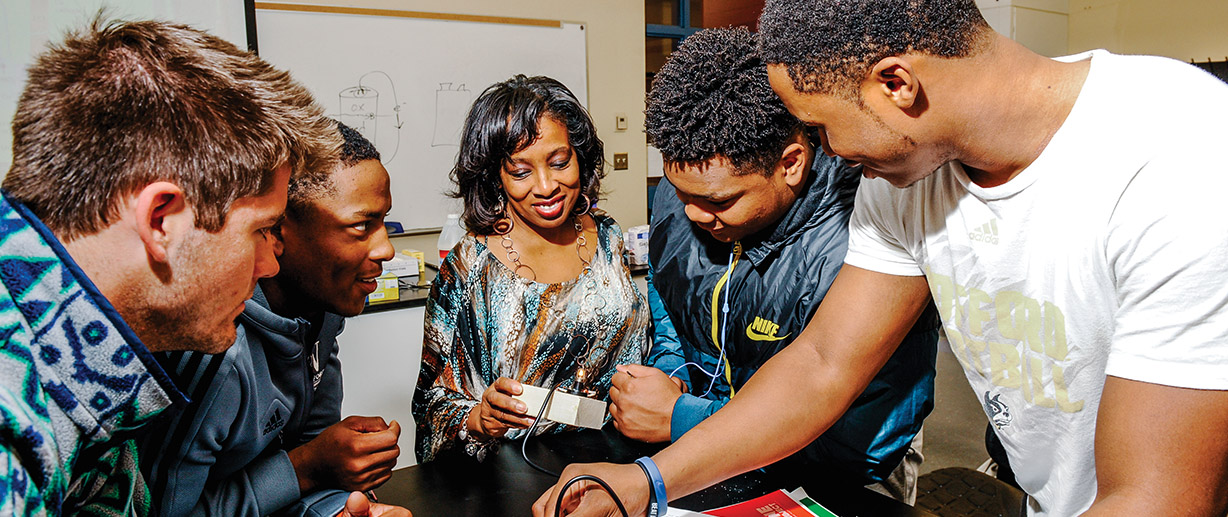
DR. JAMEICA BYERS HILL ’88
The first woman to teach in the sciences at Wofford
When Dr. Jameica Byers Hill ’88, professor of chemistry, was named associate provost, it could have meant a new office out of the busyness of the Roger Milliken Science Center, but she chose to stay put.
“Being a member of an underrepresented population in STEM, I wanted to stay in the building. I felt I needed to be seen in this space,” says Hill, who’s made Wofford history in several ways:
- The first woman to teach in the sciences at Wofford.
- The first Black woman to earn tenure at Wofford.
- The first woman to serve as faculty athletics representative.
“There weren’t any women teaching in the building when I started,” says Hill, who tops the list of loyal, engaged, active and productive Wofford graduates. “Wofford has always been my place, and I don’t have some of the overcoming stories that others do. That just wasn’t my experience, maybe because it wasn’t pointed out at the time, and definitely because of the example set by my mother and auntie.”
Hill has memories of her father preparing breakfast for her before elementary school while her mother studied.
“She was an educator who was in school,” says Hill. “After she spent the day teaching, she had to go to class. I remember wearing my Easter dress to her graduation in Clemson’s Littlejohn Auditorium.”
Hill’s aunt graduated at the same time. After earning her doctoral degree in chemistry, Hill also commenced in Littlejohn, as did her daughter, Shelby, who earned her bachelor’s degree at Clemson and who is now completing her Ph.D. in chemistry at the University of Southern California.
“My responsibility now is to be that same sort of living example that I had in my mom and auntie,” says Hill, who took classes from and looked up to two other women who were Wofford firsts — Dr. Vivian Fisher and Dr. Susan Griswold. “There were not many women on the faculty then, and to this day, I’m proud of the A I made in Dr. Fisher’s D.H. Lawrence class. I worked my butt off for that A.”
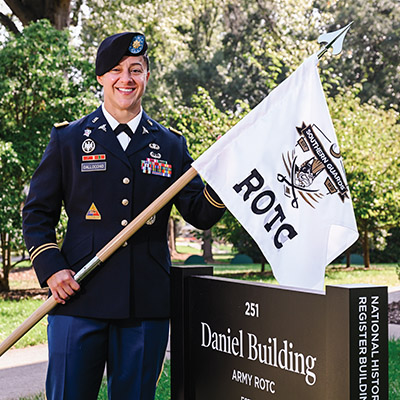
MAJ. NICOLE DALLOCCHIO
Leading the Southern Guards
Everything starts with a plan.
And Maj. Nicole Dallocchio, the first woman to serve as professor of military science and leader of the Southern Guards Battalion, has planned, executed and achieved throughout her decorated career. Now she brings her focus and energy to Wofford College, USC Upstate and Converse University as leader of the U.S. Army ROTC’s Southern Guards Battalion, founded at Wofford in 1919.
“I feel honored to have this distinction at Wofford, and I’ve received an incredibly warm welcome from the community,” says Dallocchio.
She has already updated the cadre’s graphic identity and reenergized the social media presence to better communicate with students. She’s reworked the programs website, updated the office and signage, and revamped the physical fitness program and leadership development funnel.
“ROTC is one of the nation’s oldest — and I think best — leadership development programs,” says Dallocchio. “Our program is cadet led. The curriculum is designed to introduce practical leadership development opportunities that will improve planning and communication skills, and more importantly, build confidence.” Cadets are graded in leadership positions held and receive weekly evaluations and feedback from their instructors.
Dallocchio’s strategic plan focuses on recruitment, retention, training and leadership development. She intends to commission at least 12 second lieutenants each year and set the program up for a smooth transition and continued success at the end of her assignment, which is typically 36 months.
“It’s important to get the right person in these assignments, someone who understands both the role of ROTC and the mission of the college,” says Dr. Tim Schmitz, provost. “Beyond recruiting, Maj. Dallocchio has a plan to boost mentoring and coaching, and she’s a tireless advocate for our students and career aspirations.”
ROTC was Dallocchio’s commissioning source, and she still stays in touch with and is grateful for the people who helped her find her way.
“I feel a sense of gratitude and responsibility to give back to the Army and the ROTC community,” says Dallocchio, calling herself a “wayward youth,” who was athletic but lacked direction. “A teacher and coach who had been a sergeant in the Army pulled me aside one day and said, ‘You need to join the Army or life may not go well for you.’ She was right. The Army instilled in me purpose and discipline, and it’s opened the door to an incredible life of opportunity.”
Three weeks after graduation from high school, Dallocchio left for basic training to become a combat medic. Dallocchio served in Korea and Germany before applying for the U.S. Army’s Green-to-Gold program. She was awarded a three-year Army ROTC scholarship to Eastern Michigan University, where she studied K-12 physical education, following in the footsteps of the teacher and coach who changed her life. She was the top cadet in her class of 391. After she commissioned as a second lieutenant, she served in Afghanistan as an aerial operations officer. She also served in the United States consulate general in Basra, Iraq, as an operations officer with the Department of State.
It’s unusual for someone with the rank of major and someone who originates in the Medical Service branch to become a professor of military science and lead a college ROTC program, but Dallocchio rose above hundreds of applicants. She is a full, voting member of the college’s faculty.
“Women only make up 18% of the total Army,” says Dallocchio, “and I counted eight women in the room at a recent conference with military science department chairs representing 274 institutions across the country. It’s such an honor to be one of the few. We need to empower more women to serve in leadership positions to mentor the next generation.”
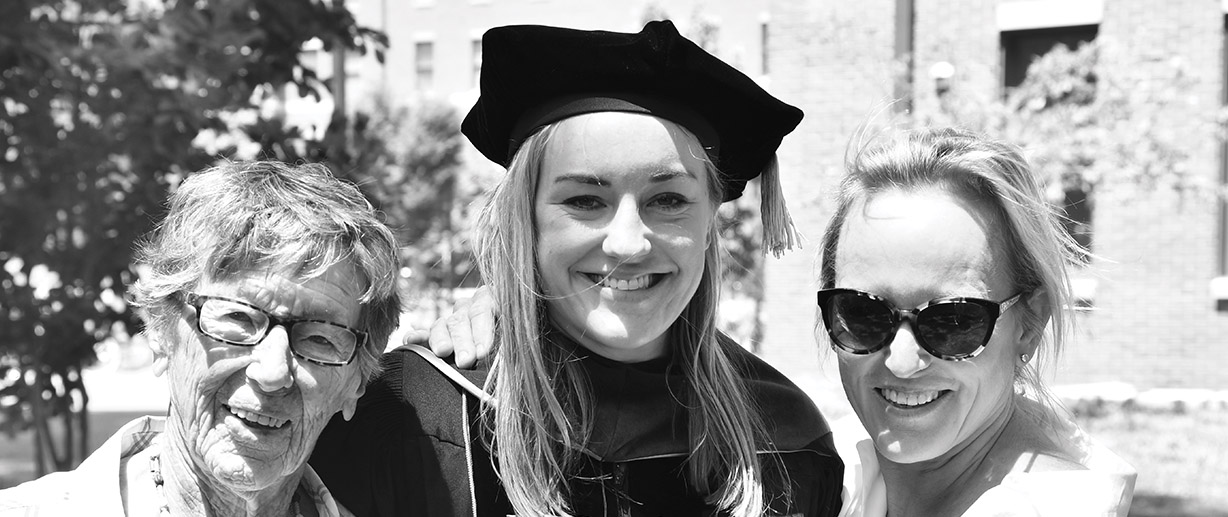
ANNE SPRINGS CLOSE
First woman to serve on and chair the Wofford College Board of Trustees
Anne Springs Close surprised her doctors one day when she showed up with an injury they normally only saw in professional athletes. Close did too many situps and pulled a muscle in her abdomen. She was 86 at the time.
“My mother did not put up with the old-fashioned ideas of women,” says her daughter, Dr. Katy Close ’83, who has followed her mother’s footsteps in service on the Wofford College Board of Trustees. “She was a tough cookie. She once went on a backpacking trip in the middle of the wilderness at 90 years old, promising me it was her last one. She tripped over a root, cut her arm open and tied it up with a bandana.”
Anne Springs Close was not only a trailblazer but also a devoted mother to eight children, grandmother to 26 and great-grandmother to 26 at the time of her death on Aug. 20, 2021. She rarely missed a life event, enthusiastically attending more than 60 graduations.
Dr. Joe Lesesne, president emertius, met Close when working on a statewide committee to celebrate the nation’s bicentennial. When the college was considering residential co-education, he called on Close, who had helped Winthrop College do the same thing. Once again, he was impressed with her, and she agreed to serve on the college’s board of trustees and help the college navigate the change. She was the first woman to serve on the board.
“Anne Close was the mother of co-education at Wofford,” says Lesesne. “She understood the landscape, the challenges and the benefits. She opened the college to new supporters and was really good at working with other board members. Anne was about as down to earth as it gets.”
According to Lesesne, when Close was asked to lead the board, “They wanted to call her chairperson. Anne said, ‘I’ve waited a long time to be a chairman, I don’t want to be a chairperson.’ So she became chairman (from 1984-86) of the board, and served well.” Close served two terms on the board, from 1974 to 1986 and again from 1988 to 1996.
“My mother loved Wofford. When my father died, the first people I saw at our house were Joe Lesesne and Wofford faculty, and they were the first people that made mama cry,” says Katy Close.
Close traveled to 60 countries during her lifetime, climbing Mount Kilimanjaro three times, the most recent at the age of 78. At 65 years old, she completed the New York marathon, persisting through an ankle sprain suffered at mile three. Close also was a pioneering force in conservation, land preservation and natural history throughout South Carolina, serving as the visionary founder of the Anne Springs Close Greenway, a 2,100-acre nature conservancy in Fort Mill, S.C.
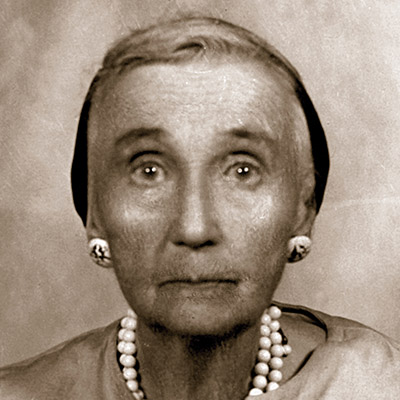
MARIE GAGARINE
The first woman to teach at Wofford and the first to speak and teach Russian
The daughter of Russian aristocrats, Madame Marie Gagarine came to Spartanburg in 1959 to be near her son, Dmitri, who worked for Milliken & Co. She was appointed to the faculty at Wofford to teach French and Russian.
Gagarine grew up in the Tsarist court and married Prince Michael Gagarine, who served in the Russian military. She was working as a nurse in a small town north of Warsaw when she learned of her husband’s death. The Russian government was near collapse, so she took her children and fled the country. Eventually, she became an American citizen.
Gagarine was active into her 90s, appearing in Wofford Theatre plays and in plays for the Spartanburg Little Theater.
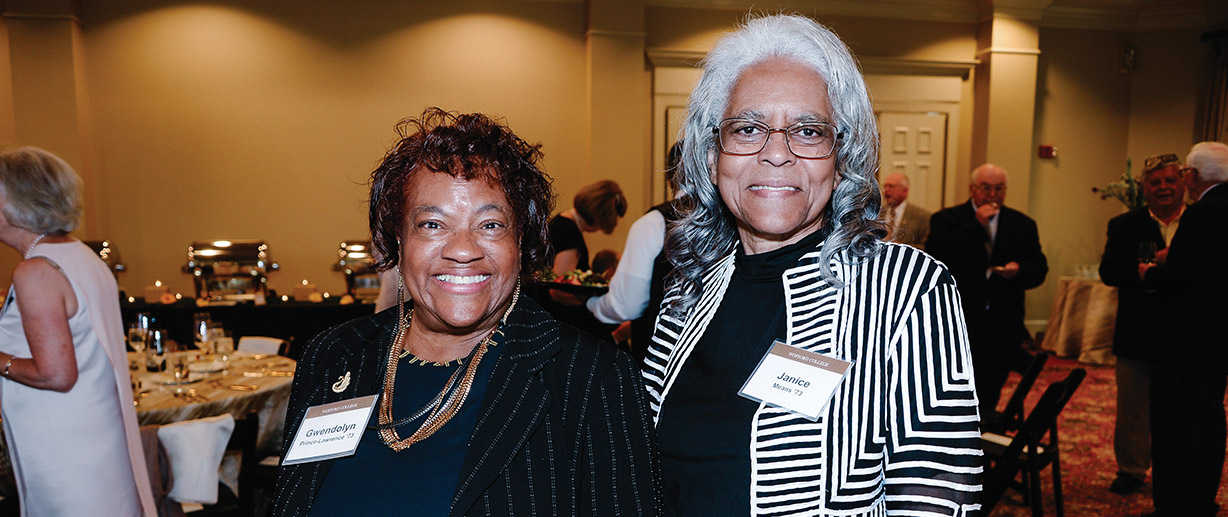
JANICE MEANS ’73 AND GWENDOLYN PRINCE-LAWRENCE ’73
The first two Black women to graduate from Wofford
Janice Means ’73 and Gwendolyn Prince- Lawrence ’73 were the first two Black women to graduate from Wofford College. They attended before Wofford implemented residential co-education. Neither set out to be history makers. Instead, they were focused on creating a financially secure future for themselves and their families. Over the summer, both women were interviewed by Dr. Dwain Pruitt ’95, chief equity officer and vice president for community initiatives, and five student researchers as part of a project to share the college’s history of desegregation, funded by a Network for Vocation in Undergraduate Education grant from the Council of Independent Colleges, supported by the Lily Endowment. Below are excerpts, written by Daniel Brasington ’25, from stories that will be published in a book in 2025.
GWENDOLYN PRINCE-LAWRENCE ’73:
A beacon of light
Prince-Lawrence did not know much about Wofford when she matriculated. In fact, despite growing up in the college’s shadow (in the Back of the College neighborhood), she and her siblings took lengths to avoid coming onto campus. When walking to Krispy Kreme to get donuts, for example, Prince-Lawrence and her siblings chose to walk around the campus to Memorial Drive. Knowing only Wofford’s reputation, Prince-Lawrence came to campus with trepidation. She expected rigorous academics and was initially worried that she would struggle compared to the “doctors’ kids, lawyers’ kids, the cream of the crop” that she had heard Wofford was known for. Once she got to campus, however, she found a different reality where she felt she could succeed academically.
She recalls that a male student held the door for her as she was walking into class on her first day on campus and that immediately relaxed her. That same day, Prince-Lawrence met Janice Means, who was the other Black woman who entered Wofford in 1971. The two became friends and would go to the library and study together when they could. Both were married and living off campus, so they found a sense of solidarity in their common experience of juggling life and school as the only Black women attending Wofford. …
Prince-Lawrence’s schedule as a Wofford student was daunting. Her husband worked second shift, so she drove him to work, then reported to work herself on the third shift. When her shift ended, it was about time to go to campus for eight o’clock classes. She would come to class sometimes without having slept at all but pushed through. Prince-Lawrence remembers one time where Dr. Lewis Jones ’38 helped her. She had studied intensely for an upcoming history final, but when she got to class that morning, she was so tired after working all night and not getting any sleep that she failed the exam. Jones came to Prince- Lawrence afterwards and offered to ask her the questions orally because he knew that she grasped the information but was too sleep-deprived to perform well on the exam. She passed the oral exam and was thankful that a member of the faculty saw that she was struggling and decided to help. …
Looking back at her time at Wofford, Prince-Lawrence has a great deal of pride in what she accomplished. When talking about her mindset, she said, “I got drive, perseverance. And I think that was the basis of my mindset. I can do anything that I try to do … I think Wofford did that for me.”
After her time at Wofford, Prince- Lawrence went on to work for the Dana Corp., which supplies axles and other automotive parts. Starting in accounting, Prince-Lawrence moved “everywhere except engineering” learning how the business worked throughout her 30-year career. Thanks to her work with Dana, she was able to travel the world doing trade shows. Now that she has retired, she works at the YMCA.
“I don’t travel much now, but I do like to travel,” she says. “I like to read. I like to sing, which I can’t sing, but I like to sing. And pretty much I’m just free. I’m just free because I’ve done so much in my life.”
JANICE MEANS ’73:
A woman on a mission
When her father died, Means was 13 and the oldest child in the household, requiring her to take on the role of the caretaker for her younger siblings when her mother was working. Means’ mother only had an eighth-grade education and her father had a third-grade education, but, according to Means, her mother “was determined that we were not going to have to work as hard as she had to work.” Means’ mother expected her children to go on to higher education and to succeed in life. They were told that being successful was their only option. …
Means recalls a negative encounter with a professor: “I had one class, and I made the mistake that first year of asking a question. He was talking Greek as far as I was concerned. I asked a question, and I realized all eyes were on me. The teacher responded, ‘I’m sorry, that was something last year, and I can’t go back. I can’t hold up the rest of the class to answer that question.’” Means determined that she would not let anyone discourage her from excelling in the way her mother expected. She set out not only to learn the material she was being taught, but also to go back daily and study what she had missed.
Not all of Means’ experiences with professors were negative, but she never felt comfortable asking for help and had to find a way to reach her goals on her own. …
Means credits her Wofford experience with her career successes. While attending Wofford, Means worked for Southern Bell, now AT&T. She continued with the company after graduating, receiving a promotion that required her family to return to Columbia. During her 28 years with the company, she “held about five or six different management positions.” After retiring, Means started her own consulting company and provided contract services to AT&T for another 18 years. …
“I reached my goal. I got my degree. I got my promotion, and my career ended up being more than I ever envisioned. I do attribute that to the fact that Wofford allowed women to attend, and I was able to get my degree. I have to look past everything else and say, ‘Okay, I was able to accomplish my goal.’ I would do it over again if the options were the same.”
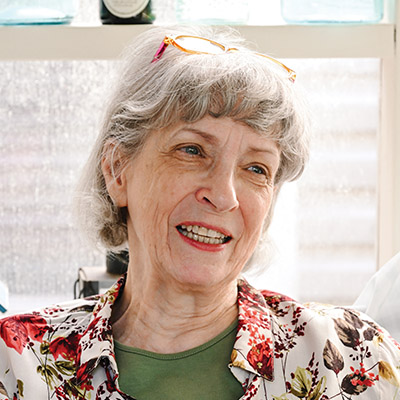
DR. VIVIAN FISHER
First woman to hold a tenure-track position at Wofford
Vivian Fisher came to Wofford in 1973.
“The way I understand it, the English department decided it was time to hire a woman in a full-time, tenure-track position. English was the first department to do that at Wofford,” Fisher says. “What I remember from those early days was prep, prep, prep for those new courses.”
Fisher’s first office was on the first floor of Greene Hall, which remains a residence hall. She remembers a young man walking into her office and sitting on the corner of her desk.
“‘Whose secretary are you?’ he asked. Change has gotta start somewhere, so I enlightened him,” says Fisher. “Turns out he was a student in my class.”
Fisher made lifelong friends at Wofford with Dr. C.L. “Ab” Abercrombie, Dr. J.R. Gross, Dr. Harris Chewning, Dr. Walt Hudgens, the Racines and the Maultsbys. She enjoyed her department and adored her students, some with whom she still keeps in touch.
“I became friends with Constance Armitage Antonsen when she came back to Wofford. In addition to letting me work out with her fencing Interim, she was kind enough to let me audit one of her classes. I think it was history of architecture,” says Fisher. “I was also able to be in some plays. At the time, there were no women to take the women’s roles, so I volunteered.”
Like so many others who were “firsts,” Fisher didn’t think of herself in those terms.
“Although it was obvious at faculty meetings,” she says. “Wofford was smart to begin admitting women and hiring more women to teach. By admit-ting women as students, they doubled the pool of outstanding students, and the college’s profile improved.”
Now Fisher spends much of her time reading. She is rereading some of the authors she taught such as Thackeray, Dickens, Lawrence and Eliot, and she’s rediscovering some of the books that have made their way onto banned books lists, like “The Color Purple.” Fisher also works on her historic home and garden in Hampton Heights and manages several historic rental properties.
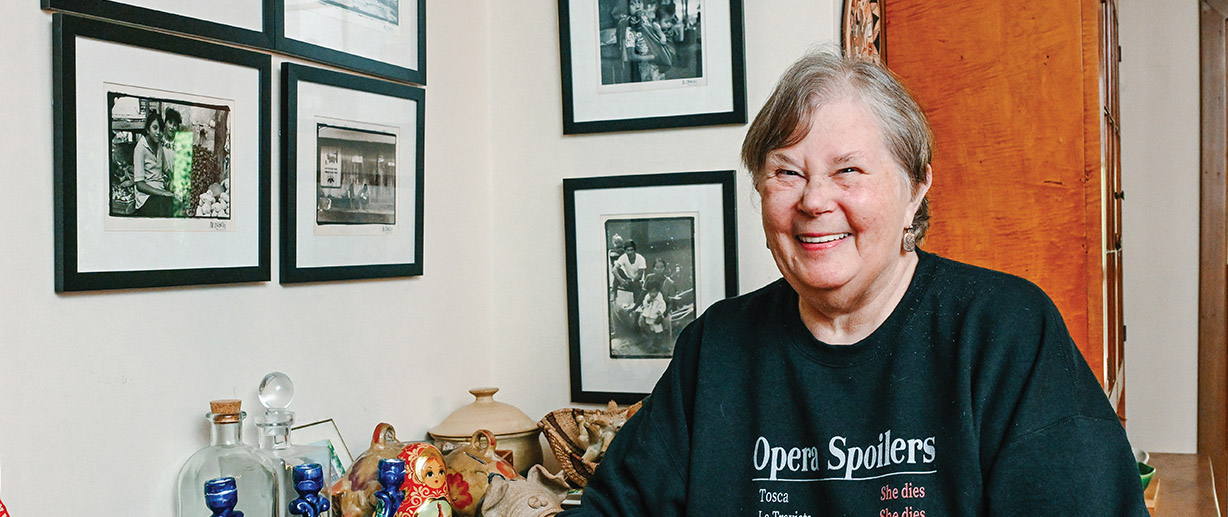
DR. SUSAN GRISWOLD
The first woman to lead an academic department
Not long after arriving at Wofford College in 1980 to chair the Department of Foreign Languages, now the Department of Modern Languages, Literatures and Cultures, “Dr. Griswold” — Susan Griswold — received an invitation from the president of the Faculty Wives Club.
“The well-meaning note said to make sure to tell my wife to attend the next meeting,” says Griswold. “I was the first woman to lead an academic department, and some colleagues — and their spouses — didn’t know what to think.”
“Some people didn’t know how to behave.” Griswold remembers faculty in the department encouraging their students to leave crass and even mildly threatening comments regarding her position and leadership on course evaluations so she would see them.
“I didn’t do anything about most of it, but fighting for equality made me more war-like,” she says. “They didn’t even know what to call me at first. I didn’t want to be a chairwoman — or even worse a chair — so I think I just said let’s go with chairman.”
Griswold’s first teaching assignment was at Middlebury College in Vermont. She had spent two years in Spain as a Fulbright and was teaching Spanish at Indiana University Bloomington when Dr. B.G. Stephens ’57, who was dean at the time, recruited her to Wofford to lead the department.
After 29 years as chairman of the department, Griswold, who was called Grisly by some, is most proud of helping the college develop a culture of study abroad.
“When I got there, there was maybe one student who was studying abroad in Europe,” she says. “I knew the best way to understand the world is to live with it. Our students were at a disadvantage until we began to develop relationships with study abroad partners and made that an important part of the educational experience.”
Traveling with students was one of her greatest pleasures. She took several trips to Mexico as well as to Spain, Honduras, Venezuela and Argentina. Griswold and colleague Dr. Camille Bethea ’92, who now leads the department, made history by taking a group of students, faculty, staff and alumni to Nicaragua as election observers when Daniel Ortega was voted out of office.
“It was called a lesson in democracy, and Roger Milliken financed it,” remembers Griswold.
Griswold remains grateful for the colleagues that taught her how to navigate Wofford in those early days.
“Dan Maultsby, Vivian Fisher, J.R. Gross, Phil Racine, Lewis Jones, Vic Bilanchone, John Bullard, Jim Keller … they were all excellent colleagues, mentors and friends,” says Griswold.
After retirement, Griswold continued to travel the world with her husband, John Morton. Their Spartanburg home is filled with photos and art from a lifetime of study abroad.
“Getting to know the students was the best part. Then persuading them that they had to dig,” Griswold says. “Wofford was a wonderful place to teach and learn. My students taught me really well, and that was such a joy.”
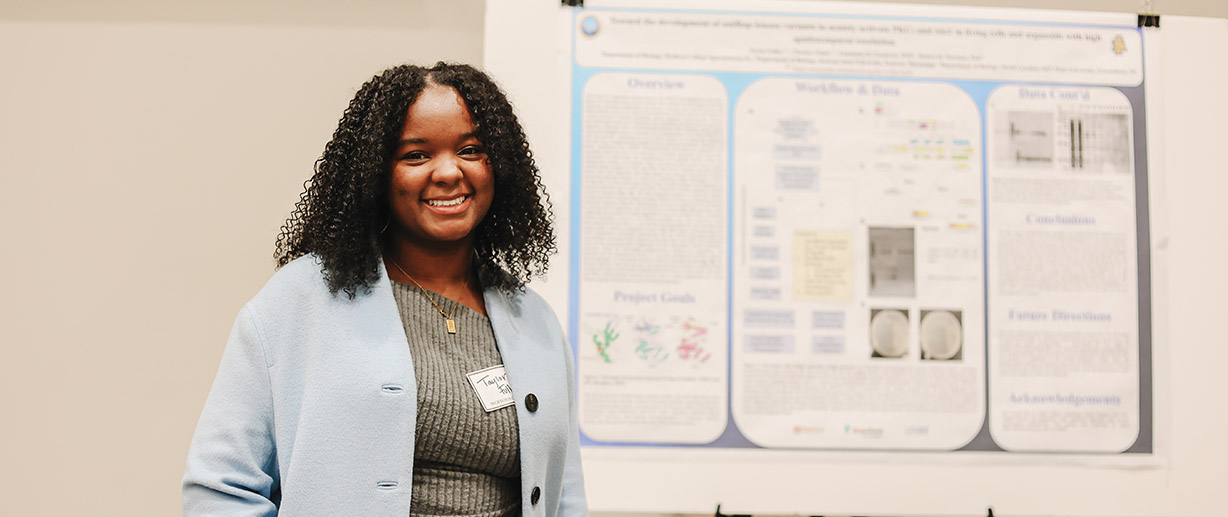
TAYLOR FULLER ’24
Filling a void as founder of Minorities in STEM
Taylor Fuller ’24 saw a void and decided to fill it. In the process, the biology major from Roebuck, S.C., became the founder of Minorities in STEM and another woman to make Wofford history.
Fuller was a sophomore in spring 2022, serving as a teaching assistant for Dr. Lisa Cantwell, assistant professor of biology. They held weekly meetings, and one week the subject was the need for a space where minority STEM (science, technology, engineering and math) students could connect over a common thread.
“We talked about the need for a support system,” says Fuller. “We wanted to come up with a way to branch the minority community and stem students at Wofford and create a space for them.” From that conversation, Minorities in STEM was born.
“We talked about it one day, and Taylor texted me two days later saying that about 20 people had expressed an interest in joining,” says Cantwell.
Fuller says the organization’s mission is to create opportunities, a support system and a space to enhance networking. By the end of the first year, the group had grown to 35. Membership is now up to 61.
“The community support has been amazing,” Fuller says. “We’ve created a place where students of color, LGBTQ+ students and students from all socioeconomic backgrounds can come together and celebrate their love of STEM.”
Minorities in STEM has hosted a variety of panels and guest speakers, as well as mental health events such as skating and movie nights. It also has hosted a BIPOC mixer during Homecoming the past two years. Members have performed community service, raising funds to support Cleveland Elementary School’s STEM program and partnering with BirthMatters, an organization that provides doula services to young women.
“Taylor has literally knocked every ball thrown at her out of the park,” says Cantwell. “She’s pushed and pushed and made so many things happen.”
Fuller’s ultimate goal is to become a pediatric cardiologist. It’s something she’s wanted since taking a biomedical science course as a ninth grader at Dorman High School. Getting Minorities in STEM up and running made her realize she can get there.
“I learned from working with this organization that I do have the leadership skills necessary to go into the field I want,” Fuller says. “By overcoming challenges, I think I’ve grown tremendously as a person and a leader.”
